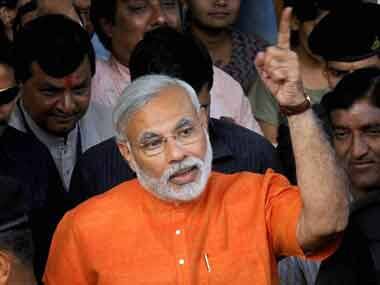Narendra Modi plays his most crucial card finally, deftly and subtly. The symbolic value of his choice of Varanasi – home to temples, spiritualism, old world Hinduism and political Hindutva as well - is hard to miss. After working hard to dissociate himself from the image of a Hindutva hard liner all these years and running a long election campaign on the agenda of development and governance, he could not have afforded to be explicit about the reason behind his choice. But the message that goes out is clear: he has not abandoned the Sangh Parivar universe, and he still banks heavily on it for votes.
Narendra Modi. PTI
It could be a sign of desperation. All recent poll surveys suggest that the BJP would still fall short of 272 seats by a considerable margin even if it performs its best. The recent NDTV-Hansa survey, the biggest in the country so far, puts the party’s tally at 195. More generous surveys earlier have placed it in the territory of 220. Clearly, the Modi wave, like everything else about Modi, was overhyped. His aggressive Indira Gandhi-style rallies across the country, and the well-orchestrated social and other media campaign are not delivering enough. To make matters worse, the Kejriwal-led AAP has started punching big holes in the Gujarat growth story at a crucial moment. In a deliberate move, it has started attacking the media, raising serious moral-ethical questions about its role in promoting Modi. The party has been panned for taking on the media, but the attack has served its purpose. In the crucial weeks before the elections all media outlets will be cautious about going gung-ho about the BJP’s prime ministerial candidate. Media’s neutrality at this juncture might prove detrimental to the party’s interests. Perhaps aware of the limitations of Modi’s outreach programme and the emerging challenges, the party has gone for aggressive social engineering in battleground states like Bihar and Uttar Pradesh in the last few weeks. Surveys say with its best efforts the BJP may secure maximum 40 seats out of the total 80 in UP, while it could end up with 20 of Bihar’s 40 seats. This is bad news for a party claiming to be riding a wave. This explains the frenzied effort of the party to rope in as many caste-based smaller parties as possible. Also, portraying Modi in caste terms – as an OBC - in these states betrays signs of lack of confidence. The caste card having been played, the BJP is back to pandering to its original loyal base: the Hindu vote bank. This was always part of the party’s two-pronged strategy in UP – while the Modi goes around the nook and corner of the state talking growth, development and neutral topics, the Sangh Parivar silently works towards polarizing votes on communal lines. The presence of Amit Shah, the trusted aide of Modi, in the state meant that the party aimed to replicate its Gujarat success formula in UP too. The announcement of Modi’s name from party stronghold Varanasi was perhaps in the original game plan. The news of resentment by sitting MP and senior leader Murli Manohar Joshi was a ploy to keep the media interest alive on Modi’s moves. His arrival in Varanasi is expected to energise the Sangh Parivar cadre across the state and provide the party the last-minute big push towards numbers it expects. Of course, Modi’s supporters would be careful about being overt about the communal card. During his last visit here in December, he visited the Sankatmochan and Kashi Vishwanath temples, seeking blessings of the deities. A few more visits to temples dotting the city would convey the message to the target group. In a city saturated with Hindutva ideology, he need not speak much.


)
)
)
)
)
)
)
)
)



